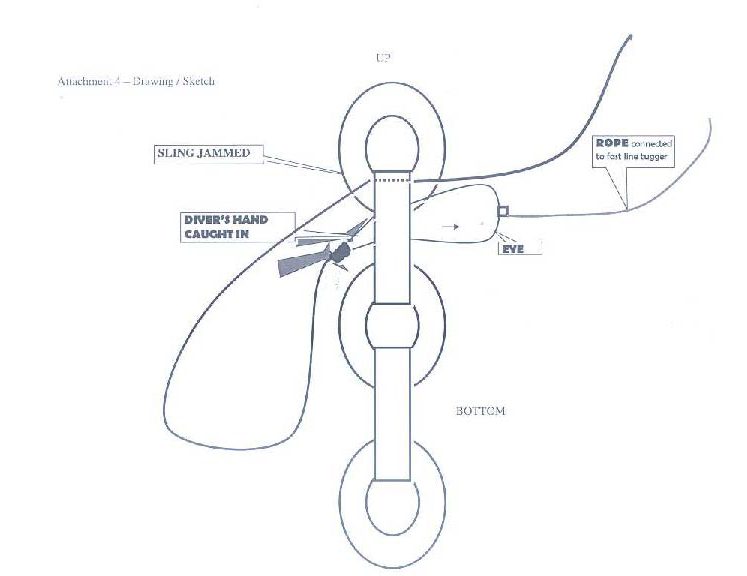Hand injury sustained by diver
A member has reported an incident in which a diver sustained an injury to his hand. The incident occurring during diving operations that were part of the installation of mooring chains for a catenary anchor leg mooring (CALM) buoy.
In an attempt to free a bight of a fouled transfer sling from its pinch point between two mooring chain links, the free hanging eye of the jammed wire rope was secured to a soft line for passing through the link and back to the surface crew on the buoy (see diagram). The intention was for the soft line to be hauled up, with the wire rope to follow. Once the eye had been pulled up to the chain it became necessary for the diver to reduce the diameter of the eye in order for it to pass through the link. Whilst the diver was working to accomplish this, the soft line which had previously been hauled by the riggers on the buoy was attached to a fast tugger winch on the vessel crane in preparation to assist in freeing the sling. The diver was not informed that this change had taken place.
After readying the eye for passage through the chain link, the diver gave the instruction to come up on the soft line. As he was in the process of manipulating the eye 90 degrees to ease its passage, it suddenly shot through and pinned his wrist against the chain. The diver immediately requested slack, but after a few seconds of increasing pressure on his wrist he opted to cut the soft line and free himself. After he returned to the surface, examination of his wrist on the vessel indicated no traumatic internal damage. The diver was sent ashore for x-rays to rule out fractures. He has since returned to work after a period of recuperation.

The company noted the following:
- The reaction by the diver and the response by the deck crews, dive team/standby diver and vessel medics was immediate and well executed;
- A thirty minute ‘safety stand down’ was ordered and took place;
- Although the diver’s hand was in ‘the wrong place’, it was noted that he had not been informed of the transfer of the soft line to the crane;
- An identical jamming of the transfer sling had occurred without incident on the previous dive. A suggestion had been made after the prior incident to use a shackle to mitigate the chances of a repetition of the incident, but this had not been seen as necessary at that time;
- The video footage of the incident was not removed as evidence and had been subsequently taped over;
- Though a task risk analysis (TRA) had been performed, which had addressed rigging hazards and the need for good communications, a number of people involved in a supervisory role in the operation had not taken part.
The company has made the following recommendations and instigated the following actions:
- An alternate method for rigging the transfer sling, using a shackle, is to be used for future tasks;
- A checklist is to be created for post-diving incident events to ensure that such items as the video recording and other evidence are gathered and secured properly. Ongoing upgrade to DVD and HDD recordings will help alleviate the shortcomings of the VCR method;
- There is to be a review of communications between vessel management and divers to ensure gaps and delays are reduced;
- Supervisory training in the management of change process is to be conducted to ensure the awareness, documentation and communication of task hazards to all involved with the job.
- The use of a shackle on the mooring chain when performing this task is to be appropriately documented as formal procedure.
Safety Event
Published: 30 April 2006
Download: /home/storm/sites/dev-imca-int-com-1/public/wp-content/themes/imca-website-2020/single-safety-events.php on line 55
">
IMCA Safety Flashes
Submit a Report
IMCA Safety Flashes summarise key safety matters and incidents, allowing lessons to be more easily learnt for the benefit of all. The effectiveness of the IMCA Safety Flash system depends on Members sharing information and so avoiding repeat incidents. Please consider adding safetyreports@imca-int.com to your internal distribution list for safety alerts or manually submitting information on incidents you consider may be relevant. All information is anonymised or sanitised, as appropriate.
IMCA’s store terms and conditions (https://www.imca-int.com/legal-notices/terms/) apply to all downloads from IMCA’s website, including this document.
IMCA makes every effort to ensure the accuracy and reliability of the data contained in the documents it publishes, but IMCA shall not be liable for any guidance and/or recommendation and/or statement herein contained. The information contained in this document does not fulfil or replace any individual’s or Member's legal, regulatory or other duties or obligations in respect of their operations. Individuals and Members remain solely responsible for the safe, lawful and proper conduct of their operations.
